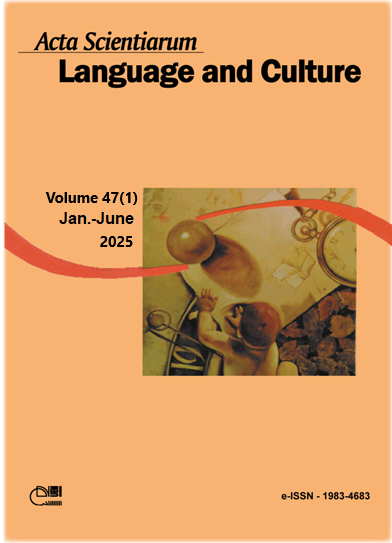The self-perception of bilinguals portuguese-talian about code-switching
Uma investigação sobre alternância de línguas
Abstract
This work aims to investigate the self-perception of bilingual who speaks Portuguese-Talian about their own code-switching practices. The practice of switch between languages is known in the literature as code-switching (CS). This is a relatively common phenomenon among bilinguals. In this study, we investigated the case of bilingual Portuguese-Talian. We apply the Assessment of Code-Switching Experience Survey questionnaire to a bilingual group composed of 19 Portuguese-Talian participants in a community of Italian descendants in Rio Grande do Sul. The questionnaire is composed of seven questions and verified in which situations and interlocutors the use of CS is more used in the investigated group. Through the answers obtained from study participants, it was observed that in family situations and with friends, the use of CS is more frequent. In addition, it was also verified why the bilinguals used CS. It was found that the participants declared switching between languages, for example, when they do not remember a word in one of the languages and mainly because they feel more comfortable using Portuguese and Talian alternately.
Downloads
References
Balthazar, L. L. (2024). Diferenças entre Italiano standard, Vêneto e Talian. http://www.letrasitaliano.ufpr.br/?page_id=137#:~:text=O%20Talian%20%C3%A9%20uma%20l%C3%ADngua,morfologia%2C%20sintaxe%20e%20l%C3%A9xico%20espec%C3%ADfico
Beatty-Martínez, A. L., Navarro-Torres, C. A., & Dussias, P. E. (2020). Codeswitching: a bilingual toolkit for opportunistic speech planning. Frontiers in Psychology, 11(1699). https://doi.org/10.3389/fpsyg.2020.01699
Blackburn, A. (2013). M. A study of the relationship between code switching and the bilingual advantage: evidente that language use modulates neural índices of language processing and cognitive control [Dissertation of Master’s degree, University of Texas].
Bullock, B. E., & Toribio, A. J. (2009). Themes in the study of code-switching. In B. Bullock, & A. J. Toribio (Orgs.), The Cambridge handbook of linguistic code-switching (pp. 1-18). Cambridge University Press.
Butler, Y. G., & Hakuta, K. (2006). Bilingualism and second language acquisition. In T. K. Bhatia, & W. C. Ritchie. The handbook of bilingualism (pp. 114-144). Blackwell.
Certidão Talian. (2014). Instituto do Patrimônio Histórico e Artístico Nacional. Ministério da Cultura.
Clyne, M. G. (1980). Triggering and language processing. Canadian Journal of Psychology, 34(4), 400-406. https://doi.org/10.1037/h0081102
Comiotto, A. F., Mota, M. B., & Soares, E. C. (2020). Code-switching em bilíngues talian-português sob uma abordagem psicolinguística. Revista Linguagem & Ensino, 23(4), 1121-1144. https://doi.org/10.15210/rle.v23i4.18570
Dal Picol, G. (2013). A morfossintaxe na oralidade do vêneto sul-rio-grandense: perfil dialetal de comunidades rurais da região da 4ª légua, Caxias do Sul/RS [Dissertação de Mestrado em Letras, Cultura e Regionalidade, Universidade de Caxias do Sul].
Diversidade Linguística do RS: inventariar, reconhecer, salvaguardar, promover. (2018). Contribuições para um planejamento estratégico de ações para a diversidade linguística do Rio Grande do Sul. Colegiado Setorial da Diversidade Linguística do RS. https://www.ufrgs.br/projalma/wp-content/uploads/2019/03/Documento_Colegiado-Setorial-da-Diversidade-Lingu%C3%ADstica-do-RS_2018.pdf
Exploring the Wonders of Bilingualism. (2023). Official site of the Assessment of code-switching experience survey. https://pinklab.wixsite.com/acses
Grosjean, F. (2008). Studying bilinguals. Oxford University Press.
Grosjean, F. (2020). How many are we? On the difficulty of counting people who are bilingual. Psychology Today. https://www.psychologytoday.com/intl/blog/life-bilingual/201209/how-many-are-we
Guzzo, N. B. (2023). Brazilian Veneto (Talian). Journal of the International Phonetic Association, 53(3), 1167-1181. https://doi.org/10.1017/S002510032200010X
Harsch, C., & Malone, M. E. (2021). Language proficiency frameworks and scales. In P. Winke, & T. Brunfaut. The routledge handbook of second language acquisition and language testing (pp. 1-12). Routledge.
Heredia, R. R., & Altarriba, J. (2001). Bilingual language mixing: why do bilinguals code-switch? Current Directions in Psychological Science, 10(5), 164-168. https://doi.org/10.1111/1467-8721.00140
Instituto Brasileiro de Geografia e Estatística [IBGE]. (2024). Pinto Bandeira, Rio Grande do Sul, Brasil. https://cidades.ibge.gov.br/brasil/rs/pinto-bandeira/panorama
Kheder, S., & Khan, E. (2019). Lexical selection, cross-language interaction, and switch costs in habitually codeswitching bilinguals. Bilingualism: Language and Cognition, 22(3), 569-589. https://doi.org/10.1017/S1366728918000500
Lei nº 414, de 20 de dezembro de 2019. (20 de dezembro de 2019). Dispõe Sobre a Cooficialização da Língua Talian, à Língua Portuguesa, no Município de Pinto Bandeira. https://leismunicipais.com.br/a/rs/p/pinto-bandeira/lei-ordinaria/2019/42/414/lei-ordinaria-n-414-2019-dispoe-sobre-a-cooficializacao-da-lingua-talian-a-lingua-portuguesa-no-municipio-de-pinto-bandeira?q=talian
Miazzo, G. (2011). Afinal, o que é "talian"? Revista Italiano UERJ, 2(1), 33-45.
Montrul, S. A. (2012) Is the heritage language like a second language?. EUROSLA Yearbook, 12(1), 1-29. https://doi.org/10.1075/eurosla.12.03mon
Montrul, S. (2015). The acquisition of heritage languages. Cambridge University Press.
Muysken, P. (1997). Code-switching processes: alternation, insertion, congruent lexicalization. In M. Pütz (Ed.), Language choices: conditions, constraints, and consequences (pp. 361-380). John Benjamins Publishing Company.
Muysken, P. (2000). Bilingual speech: a typology of code-mixing. Cambridge University Press.
Pinto Bandeira. (2024). Localização. https://bitily.me/ZrDmq
Poplack, S. (1980). Sometimes I’ll start a sentence in Spanish y termino en Espanõl: toward a typology of code-switching. Linguistics, 18, p. 581-618.
Prefeitura Municipal de Pinto Bandeira. (2014). História. https://www.pintobandeira.rs.gov.br/secao.php?id=2
Slabakova, R. (2016). Second language acquisition. Oxford University Press.
Timofeeva, P., Quiñones, I., Geng, S., Bruin, A., Carreiras, M., & Amoruso, L. (2023). Behavioral and oscillatory signatures of switch costs in highly proficient bilinguals. Nature Scientific Reports, 13, 7725. https://doi.org/10.1038/s41598-023-34895-1
Valdés Kroff, J. R., & Dussias, P. E. (2023). Production, processing, and prediction in bilingual codeswitching. Psychology of Learning and Motivation, 78, 195-237 https://doi.org/10.1016/bs.plm.2023.02.004
Wei, L. (2015). Codeswitching. In W. S.-Y Wang, & C. Sun. The Oxford Handbook of Chinese Linguistics (pp. 615-625). Oxford University Press.
DECLARATION OF ORIGINALITY AND COPYRIGHTS
I Declare that current article is original and has not been submitted for publication, in part or in whole, to any other national or international journal.
The copyrights belong exclusively to the authors. Published content is licensed under Creative Commons Attribution 4.0 (CC BY 4.0) guidelines, which allows sharing (copy and distribution of the material in any medium or format) and adaptation (remix, transform, and build upon the material) for any purpose, even commercially, under the terms of attribution.
Read this link for further information on how to use CC BY 4.0 properly.




















6.png)









